Adaptive cooking tools can transform your kitchen experience if you have a disability. You’ll find ergonomic knives with curved blades that need less grip strength, one-handed stabilizing boards that secure food while cutting, and wide-grip utensils with soft handles to reduce strain. Smart kitchen tech offers voice-controlled appliances for hands-free cooking, while height-adjustable countertops improve accessibility. Discover how these innovations can help you cook independently and safely in your own kitchen.
Adaptive Knives and Cutting Tools for Enhanced Control
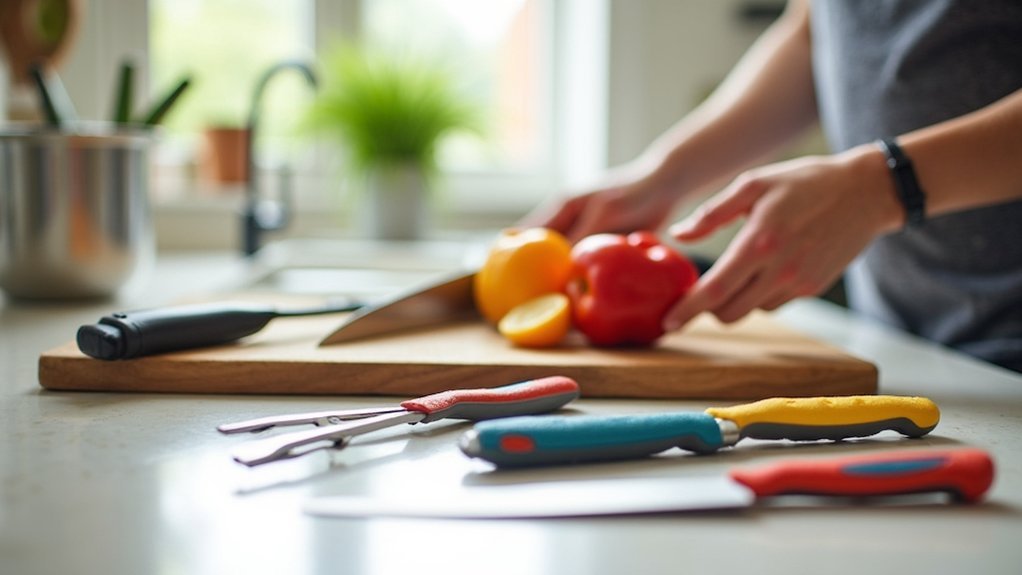
When individuals with disabilities face challenges in the kitchen, adaptive knives and cutting tools can dramatically improve their cooking experience. Rocker knives with curved blades allow you to cut food using a rocking motion, reducing the need for grip strength or wrist flexibility. These specialized tools are ideal for people with conditions like rheumatoid arthritis who need assistance with everyday cooking tasks.
You’ll find options with ergonomic handles that are taller and angled to prevent accidents, while large grip handles provide easier control if you have weak hands.
For one-handed use, consider rocker knife/fork combinations that perform multiple functions simultaneously.
These tools are specifically designed with safety in mind—many feature angled blades, wide surfaces for food manipulation, and protective guards to minimize injury risk.
With these adaptive cutting tools, you can maintain independence in meal preparation regardless of arthritis, upper limb differences, or limited strength.
Ergonomic Grip Utensils for Limited Hand Strength
Flexible silicone handles on cooking utensils can greatly reduce hand fatigue while providing a secure grip for those with limited strength.
You’ll find wide-grip options particularly helpful, as they distribute pressure across a larger area of your hand, minimizing strain during extended cooking sessions. Tools like the Rocking T Knife can make food preparation significantly easier by utilizing a rocking motion rather than traditional cutting techniques.
These ergonomic designs enable you to maintain independence in the kitchen, even when your grip strength fluctuates due to arthritis, neuropathy, or other conditions.
Flexible Silicone Handles
Three innovative features make flexible silicone handles a game-changer for people with limited hand strength.
First, they warm to your skin temperature, providing comfortable support without requiring tight grip pressure.
Second, their flexible, stretchy material enhances sensory feedback, helping you feel the weight and texture of cooking utensils with minimal effort.
Third, their ergonomic design accommodates various hand types and abilities.
You’ll find these handles on everything from eating utensils to cooking spatulas. Similar to Comfort Grip Utensils, they reduce hand fatigue during extended food preparation and mealtime activities.
They’re particularly helpful if you have conditions like Parkinson’s or multiple sclerosis.
The bendable versions can be customized to fit your specific grip needs, whether you’re right or left-handed.
These adaptive tools reduce strain during kitchen tasks, prevent dangerous slips, and ultimately promote independence and confidence in your cooking and dining experiences.
Wide-Grip Tool Options
Wide-grip tool options transform kitchen independence for those with limited hand strength or dexterity. These specialized utensils feature large, soft handles that reduce strain while providing better control during meal preparation and eating.
You’ll find Good Grip kitchen aids particularly helpful for tasks like opening jars or chopping vegetables. The soft, textured materials prevent slipping and minimize hand fatigue, even during extended use. Many options are dishwasher-safe, making cleanup convenient in both home and institutional settings.
For eating, look for adaptive cutlery sets with rocker knives that require minimal hand movement, and ergonomic spoons designed for easier scooping. Consider Weighted Utensils that are designed to reduce hand tremors during use. Some utensils can be bent to customize angles for your specific needs or preferred hand.
These thoughtfully designed tools make cooking and eating considerably more comfortable if you have arthritis, neurological impairments, or age-related strength issues.
One-Handed Cooking Equipment Solutions
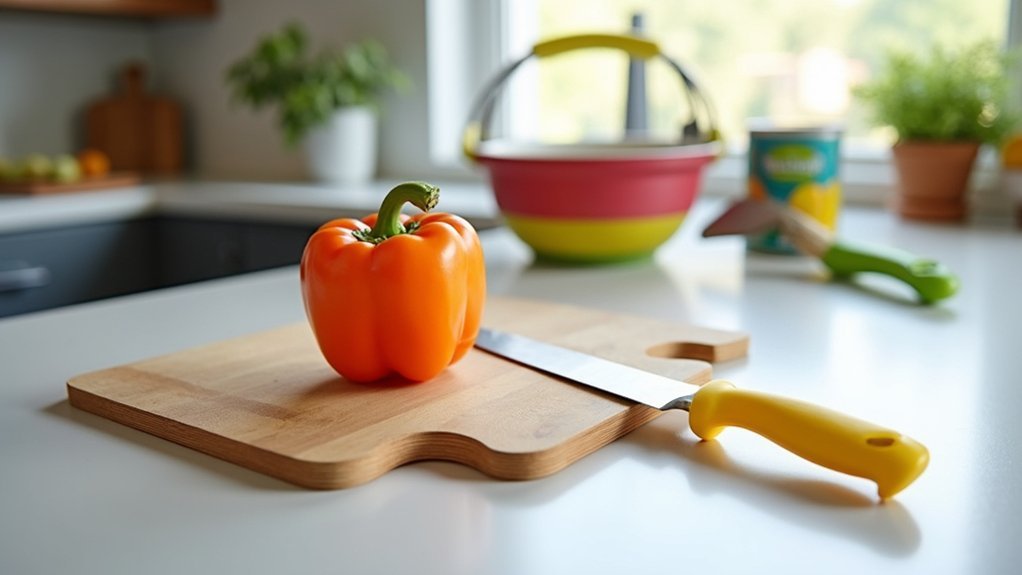
If you’re cooking with one hand, specialized cutting devices like adaptive boards and palm peelers will vastly improve your meal preparation safety.
You’ll find stabilizers and holders, including non-slip mats and cook-helper boards, essential for securing food while you work with it. The Dycem Non-Slip Activity Mat prevents bowls and cutting boards from sliding during food preparation.
Various versatile kitchen gadgets, from locking tongs to jar openers, can transform your cooking experience by making previously challenging tasks straightforward and manageable.
Specialized Cutting Devices
For individuals with limited mobility or the use of only one hand, specialized cutting devices represent essential tools that transform cooking from a frustrating challenge into an accessible activity.
Adaptive cutting boards with non-slip bases and food-securing clamps allow you to stabilize ingredients while cutting with one hand. Pair these with rocker knives, which use a curved blade requiring minimal pressure and dexterity to chop effectively. The rocking motion reduces strain on your wrists and hands.
Electric or manual choppers offer another solution, letting you dice vegetables with a simple press or pull mechanism. The one handed cutting board provides exceptional stability while preparing ingredients, eliminating the need for assistance.
For peeling tasks, specialized tools with ergonomic handles make removing skins from fruits, vegetables, and even boiled eggs considerably easier. Look for utensils with enhanced grips and right-angled handles to improve your leverage and control.
Stabilizers and Holders
Stability represents the foundation of successful one-handed cooking, and specialized stabilizers and holders make this possible. These adaptive tools secure your cookware in place, allowing you to prepare meals safely with just one hand.
Pan holders and non-slip mats prevent sliding, while plate guards keep food contained. You’ll find various clamp styles that secure items to countertops, providing the leverage you need for cutting and mixing. Ergonomic adaptive cutlery is also available to complement these stability solutions.
Many stabilizers feature heat-resistant materials and ergonomic designs that fit comfortably in your hand.
These tools greatly increase your independence in the kitchen by distributing weight evenly and reducing accident risks. Whether you’re dealing with arthritis, an amputation, or limited mobility, stabilizers adapt to your needs, making cooking tasks more accessible and enjoyable without requiring assistance.
Versatile Kitchen Gadgets
When cooking with one hand, the right equipment transforms challenging tasks into manageable ones. Look for cutting boards with raised edges and spikes that secure food while you chop, along with suction cup bases that prevent slipping.
Rocker knives and one-handed choppers make food preparation safer and more efficient.
You’ll find ergonomic utensils with enlarged or cushioned handles that improve grip and control. Right-angled designs allow easier maneuvering, while straps or loops secure utensils for limited grip strength. The Deluxe Suction Bottle Brush designed for one-handed use offers stationary brushes that make cleaning tasks much simpler.
Consider lightweight kettles and electric can openers that eliminate the need for two-handed operation.
Don’t overlook measuring aids with easy-grip handles and scoop bowls with deep rims that help transfer ingredients. These specialized tools promote independence and safety, making cooking more accessible and enjoyable.
Smart Kitchen Technology for Independent Meal Preparation
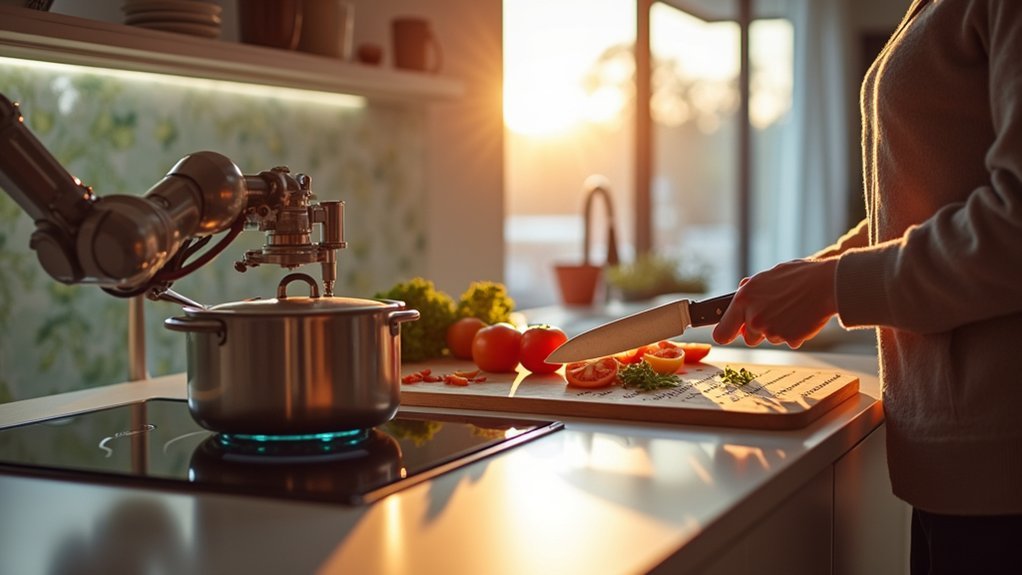
As technology continues to revolutionize home environments, smart kitchen systems have emerged as powerful tools enabling people with disabilities to prepare meals independently. These systems prioritize safety with strategically placed displays and timely alerts that warn you about hot surfaces.
You’ll find modular designs that integrate seamlessly with your existing appliances while offering step-by-step cooking guidance tailored to your specific needs. Voice-controlled features and cognitive assistive tools like the COOK system can support you through complex recipes even if you have a traumatic brain injury or other cognitive limitations. These kitchens utilize gesture controls and motion sensors to further enhance accessibility and safety in the cooking environment.
The impact extends beyond just meal preparation—you’ll experience enhanced autonomy and quality of life as these customizable technologies adapt to your preferences and abilities, making cooking accessible regardless of physical or cognitive challenges.
Accessible Food Storage and Retrieval Systems
Accessible food storage and retrieval systems transform everyday kitchen tasks into manageable activities for people with disabilities. Pull-down shelves and pulley mechanisms bring items from upper cabinets within reach, eliminating dangerous stretching or climbing.
You’ll find full-extension slides particularly helpful for accessing pots and pans stored in deep cabinets. Non-slip surfaces prevent items from sliding, while ergonomic handles accommodate various grip strengths. Cookware organizers with adjustable dividers support various pot and pan sizes, creating customized storage solutions.
For pantries, look for adjustable shelving that accommodates mobility aids. Smart labeling systems assist those with visual impairments, using tactile or auditory cues to identify contents. One-handed operation features benefit users with limited dexterity.
When selecting refrigerators, prioritize models with sliding shelves and lever-style handles for easier access. Many of these solutions integrate seamlessly with existing cabinetry, maintaining your kitchen’s aesthetic while improving functionality.
Mobility-Friendly Kitchen Layout Considerations
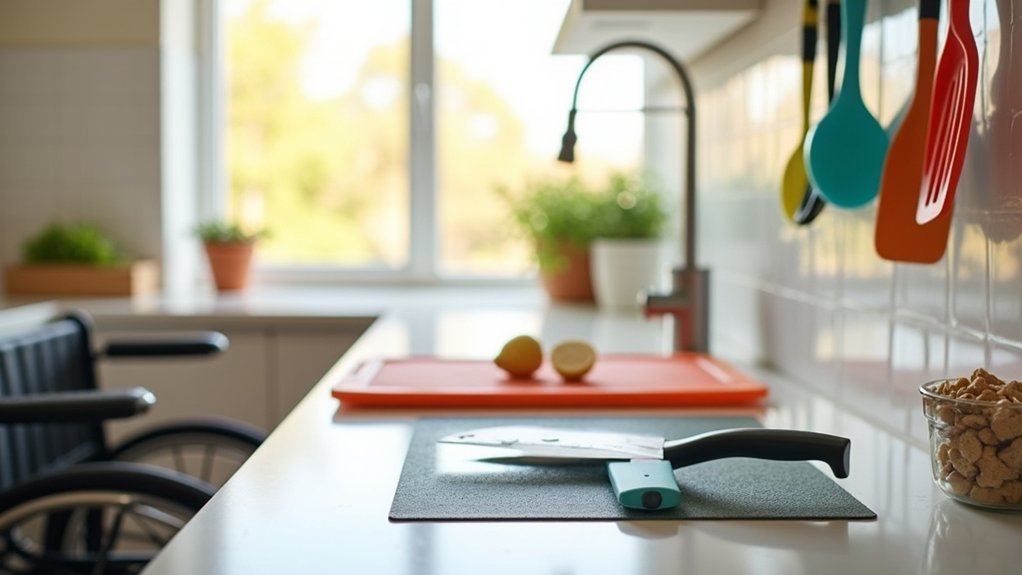
Designing a kitchen that truly accommodates mobility challenges begins with thoughtful space planning rather than simply adding accessible tools.
Your kitchen’s layout should prioritize clear pathways with at least 42 inches between counters, while U-shaped kitchens need 60 inches of open space for proper wheelchair maneuverability.
Consider these essential layout elements:
- Create roll-under countertops with knee clearance to enable comfortable seated work.
- Install side-opening appliances at accessible heights to eliminate bending and reaching.
- Make sure all cabinet shelving remains under 54 inches from the floor.
- Incorporate pull-out shelves and lazy Susans to minimize stretching.
Choose non-slip flooring without barriers that could cause tripping, and make certain all pathways remain well-lit and obstacle-free. An open concept layout significantly improves both access and maneuverability throughout the kitchen space.
These thoughtful design choices create independence beyond what adaptive tools alone can provide.
Specialized Eating Aids for Various Disabilities
Specialized eating aids transform mealtime from a daily struggle into an empowering experience for individuals with disabilities.
Weighted utensils stabilize hands for those with tremors, while bendable options adjust to unique gripping needs. For stability, consider plates with suction cups or non-slip mats to prevent unwanted movement.
If you’re facing limited mobility, one-handed utensils and rocker knives minimize necessary movements. The GripWare Round Scoop Dish offers a thoughtfully contoured design that makes easier food scooping possible for those with limited hand dexterity.
Cognitive challenges become more manageable with high-contrast or textured utensils providing visual and tactile cues.
Technology has expanded possibilities with autofeeders, smart plates with sensors, and electronically controlled utensils for precise movements.
S’up Spoons and cups with specialized lids prevent spills, while bowls with built-up rims make food capture easier.
When selecting aids, prioritize options that address your specific challenges.
Kitchen Safety Devices for Persons With Limited Vision
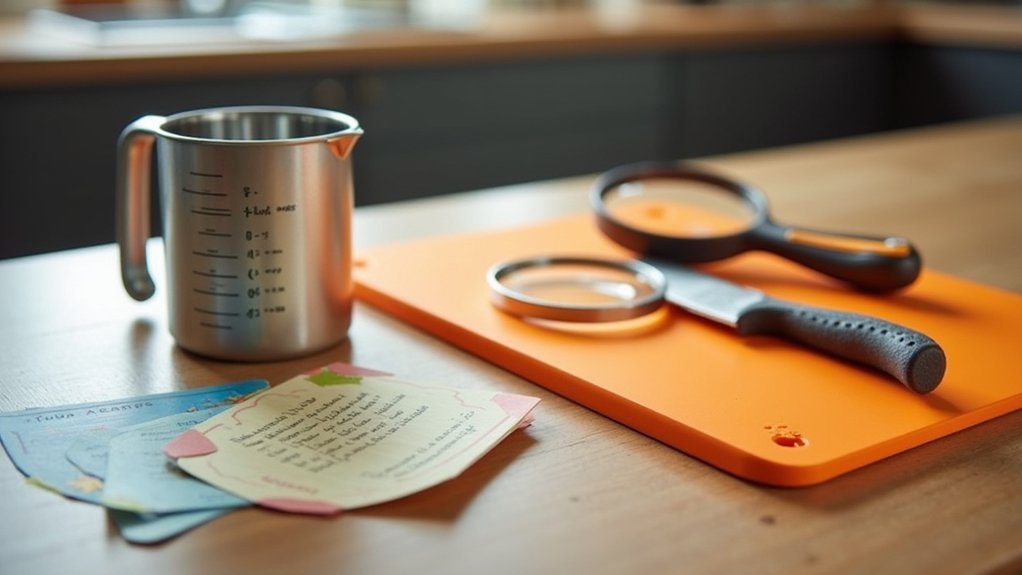
While cooking offers independence and enjoyment, individuals with limited vision face unique challenges that specialized kitchen safety devices can effectively address.
You’ll find many tools designed specifically to enhance safety through contrast, tactile features, and auditory feedback. High-contrast cutting boards help distinguish food from cutting surfaces, while finger guards protect hands during chopping tasks. The black and white cutting board provides excellent visual contrast for those with low vision.
For heat management, you’ll appreciate talking food thermometers and long, flame-retardant oven mitts that reduce burn risks.
Four essential safety devices include:
- Liquid level indicators that beep when containers are full
- Non-slip mats that stabilize bowls and cutting boards
- Push-pull oven openers that keep hands away from hot surfaces
- Tactile markers for stove knobs to prevent setting errors
Cooking Platforms and Workstations for Wheelchair Users
Adjustable height counters and workstations let you customize your cooking area to match your specific wheelchair dimensions, eliminating uncomfortable stretching or bending.
You’ll need at least 30 inches of knee clearance underneath counters (minimum 24 inches high) to comfortably position yourself during meal preparation.
These accessible platforms, especially when equipped with mobile or foldable features, can transform your cooking experience by bringing essential tools and ingredients within easy lateral reach. The Drive Medical All-Purpose Stool with adjustable arms provides additional support options when you need to work at different heights during food preparation.
Adjustable Height Solutions
For wheelchair users and people with mobility challenges, the kitchen can transform from a place of frustration to one of independence with properly designed height solutions. Adjustable height cooktops and platforms bring cooking surfaces to your comfort level with the touch of a button, accommodating both seated and standing positions.
These adaptable solutions offer:
- Motorized controls that allow easy height adjustments with minimal effort
- Customizable platforms designed to meet your specific mobility needs
- Rotating elements providing 360-degree access around cooking areas
- Smart integration with touch-screen controls and home automation systems
Height-adjustable workstations optimize your kitchen space while promoting independence, allowing you to prepare meals without assistance. The systems can be completely lowered at the touch of a button and then raised back up when cooking tasks are complete.
The ergonomic designs reduce strain during cooking activities, ensuring comfort and safety throughout the cooking process.
Workspace Clearance Features
Creating accessible kitchen workspaces involves more than just height adjustments—proper clearance dimensions make the difference between frustration and functionality for wheelchair users.
Your countertops should provide at least 24 inches high and 30 inches wide open space underneath for comfortable legroom.
Ensure pathways between workstations remain at least 36 inches wide for easy wheelchair navigation, with a 60-inch diameter turning space in cooking zones.
Opt for open-front sinks and work surfaces without obstructive cabinetry to allow direct approach.
Front-access faucets positioned near the sink’s edge reduce strain, while side-hinged oven doors offer better accessibility than traditional downward-opening designs.
Consider installing smart appliances that can be controlled remotely to further enhance independence and ease of use in the kitchen.
Remember that all workspace features should be within 15 to 48 inches from the floor—the ideal reach range for seated users.
Voice-Controlled Appliances for Hands-Free Cooking
Modern technology has revolutionized accessibility in the kitchen through voice-controlled appliances that enable hands-free cooking experiences.
You’ll find virtual assistants like Alexa, Siri, and Google Assistant ready to help you control kitchen appliances without physical contact, which is particularly beneficial if you have limited dexterity or mobility challenges.
These voice-activated systems offer:
- Enhanced safety by reducing physical interaction with hot or sharp appliances
- Greater independence through hands-free operation of ovens, microwaves, and other devices
- Spoken instructions and reminders for users with cognitive impairments
- Integration with broader smart home systems for complete environmental control
As AI technology advances, voice recognition continues to improve, expanding capabilities and making cooking more accessible for people with various disabilities. Specially designed cooking tools like the Microwave with Rotary Dial provide easier operation for individuals with low vision through simplified controls.
Frequently Asked Questions
How Can I Fund or Get Financial Assistance for Adaptive Cooking Equipment?
You can get financial assistance through Medicaid, VA benefits, SSI, rehabilitation programs, state AT programs, private foundations, civic organizations, grants, non-profits, community fundraising, or employer assistance for adaptive cooking equipment.
What Cooking Tools Work Best for Children With Disabilities?
For children with disabilities, you’ll find youth weighted utensils, curved spoons, grip-aids, and universal cuff holders extremely helpful. Also consider color-coded tools, sensory-friendly equipment, and easy-grip measuring cups for independence in the kitchen.
Are There Cooking Classes Specifically Designed for People With Disabilities?
Yes, you’ll find dedicated cooking classes like Culinary Kids, Food Vibez, Big Wave Project Academy, and Tech Kitchen Program. They’re designed to develop independence, social skills, and nutritional knowledge for people with disabilities.
How Do I Adapt Existing Kitchen Tools Instead of Buying Specialized Ones?
You can adapt existing kitchen tools by adding foam or rubber to handles, creating custom grips, attaching velcro for one-handed use, applying contrasting colors for visibility, or using magnetic strips to secure items.
Which Adaptive Cooking Tools Are Best for Traveling or Cooking Away From Home?
For traveling, you’ll want collapsible utensils, multi-functional tools, and lightweight options. Pack silicone cooking tools, non-slip mats, one-handed adaptive utensils, and battery-operated devices that don’t require outlets when cooking away from home.
In Summary
You’ve got access to an impressive array of adaptive kitchen tools that can transform your cooking experience. Whether you’re dealing with mobility issues, vision impairments, or hand strength limitations, there’s specialized equipment designed for your needs. By incorporating these accessible tools into your kitchen, you’ll regain independence and confidence in meal preparation while ensuring your safety and comfort throughout the cooking process.

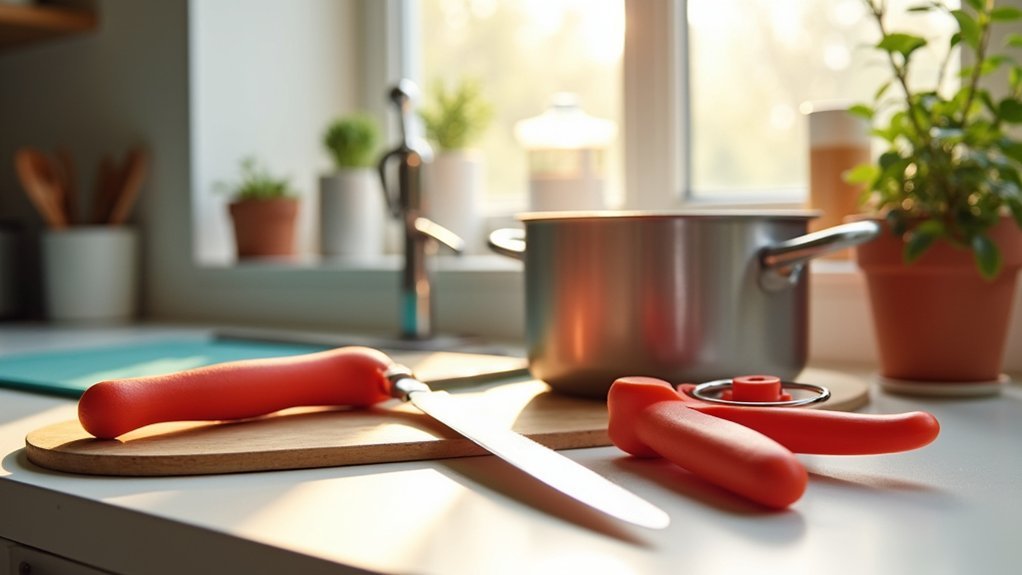



Leave a Reply